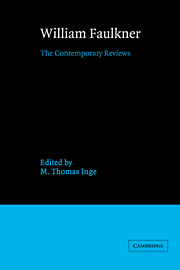Book contents
- Frontmatter
- Contents
- Series Editor's Preface
- Introduction
- Acknowledgments
- The Marble Faun (1924)
- Soldiers' Pay (1926)
- Mosquitoes (1927)
- Sartoris (1929)
- The Sound and the Fury (1929)
- As I Lay Dying (1930)
- Sanctuary (1931)
- These Thirteen (1931)
- Salmagundi and Miss Zilphia Gant (1932)
- Light in August (1932)
- A Green Bough (1933)
- Doctor Martino and Other Stories (1934)
- Pylon (1935)
- Absalom, Absalom! (1936)
- The Unvanquished (1938)
- The Wild Palms (1939)
- The Hamlet (1940)
- Go Down, Moses and Other Stories (1942)
- The Portable Faulkner (1946)
- Intruder in the Dust (1948)
- Knight's Gambit (1949)
- Collected Stories (1950)
- Notes on a Horsethief (1950)
- Requiem for a Nun (1951)
- Mirrors of Chartres Street (1954)
- The Faulkner Reader (1954)
- A Fable (1954)
- Big Woods (1955)
- The Town (1957)
- New Orleans Sketches (1958)
- Three Famous Short Novels (1958)
- The Mansion (1959)
- The Reivers (1962)
- Index
Salmagundi and Miss Zilphia Gant (1932)
Published online by Cambridge University Press: 07 September 2009
- Frontmatter
- Contents
- Series Editor's Preface
- Introduction
- Acknowledgments
- The Marble Faun (1924)
- Soldiers' Pay (1926)
- Mosquitoes (1927)
- Sartoris (1929)
- The Sound and the Fury (1929)
- As I Lay Dying (1930)
- Sanctuary (1931)
- These Thirteen (1931)
- Salmagundi and Miss Zilphia Gant (1932)
- Light in August (1932)
- A Green Bough (1933)
- Doctor Martino and Other Stories (1934)
- Pylon (1935)
- Absalom, Absalom! (1936)
- The Unvanquished (1938)
- The Wild Palms (1939)
- The Hamlet (1940)
- Go Down, Moses and Other Stories (1942)
- The Portable Faulkner (1946)
- Intruder in the Dust (1948)
- Knight's Gambit (1949)
- Collected Stories (1950)
- Notes on a Horsethief (1950)
- Requiem for a Nun (1951)
- Mirrors of Chartres Street (1954)
- The Faulkner Reader (1954)
- A Fable (1954)
- Big Woods (1955)
- The Town (1957)
- New Orleans Sketches (1958)
- Three Famous Short Novels (1958)
- The Mansion (1959)
- The Reivers (1962)
- Index
Summary
Harry Hansen. “The First Reader.” Greensboro Daily News, May 15, 1932, Section II, p. 4.
William Faulkner and Ernest Hemingway appear together in Salmagundi, a thin book of early writings just prepared by Paul Romaine and published by Casanova Press, of Milwaukee, Wis. True, the Hemingway is but four lines long, but it gets him on the title page. The articles and poems, with one exception, appeared in the Double Dealer, of New Orleans, and are being reissued with “the amusing permission” of Faulkner.
Upon reading these early writings of William Faulkner we find impressionistic sketches, irrelevant comment on American criticism, an autobiographical fragment discussing the influence of Swinburne on himself as a lad of 16 and a group of poems, including “L'Apres-Midi d'un Faune,” said to be Faulkner's first published work. It appeared in the New Republic, August 6, 1919.
In 1925 we discover Faulkner writing:– “Is there nowhere among us a Keats embryo, some one who will turn his lute to the beauty of the world? Life is not different from what it was when Shelley drove like a swallow southward from the unbearable English winter; living may be different, but not life. Time changes us, but time's self does not change. Here is the same air, the same sunlight in which Shelley dreamed of golden men and women immortal in a silver world and in which young John Keats wrote ‘Endymion’ trying to gain enough silver to marry Fannie Brawne and set up an apothecary's shop.
- Type
- Chapter
- Information
- William FaulknerThe Contemporary Reviews, pp. 75 - 80Publisher: Cambridge University PressPrint publication year: 1995

